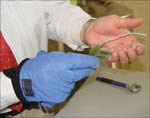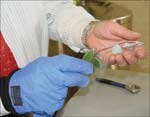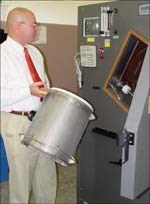A Cool Technology
Cryogenic technology offers a clean, efficient approach to deburring and deflashing of metal and plastic parts…
These days, mention the words “cryogenic technology” to the average man or woman on the street and they’re likely to roll their eyes and mumble something about Ted Williams, before offering a dismissive wave.
“Cryogenics—as a science—gets a bad rap,” says Robin Rhodes. “A lot of people don’t understand it, and they’re not willing to invest the time or resources in order to learn more about it.”
Rhodes is the president of the Cryogenic Institute of New England, Inc., a Worcester, MA-based outfit that offers cryogenic deburring and deflashing, as well as cryogenic tempering of steel and other metals (see sidebar on page 56). For the record, his business has nothing to do with preserving the bodies of dead baseball legends.
Rhodes points out that the reality of cryogenics is that various aspects of it have been around for hundreds of years. “Swiss and German watchmakers used a process called ‘seasoning’ where they would take their steel and put it outside over the winter season in order to make the metal more stable and easier to work with.”
Rhodes—who left a high-level job with an electronics corporation in order to pursue his dream of owning a company of his own—formed the Cryogenic Institute in March, 2002. Initially, he intended to focus solely on cryogenic tempering, but realizing the possibilities afforded by cryogenics, added deflashing and deburring to his company’s repertoire of services a year later. He has since added cryogenic material separation (rubber debonding), shrink fitting and cryogenic grinding as well. “My goal is to make the company into a boutique of cryogenic services,” he says.
Cryogenic Deburring
Cryogenic deburring—an offshoot of cryogenic deflashing—uses a system whereby parts are placed in a chamber, exposed to extremely cold temperatures (achieved with the use of liquid nitrogen) and then tumbled and blasted with a polycarbonate media. Because the burrs have a high surface area relative to their mass, they “freeze” very quickly and become brittle. The tumbling action—combined with the impact of the media—removes the burrs without damaging the part itself.
After the process is complete, parts are returned to room temperature. Rhodes says that cryogenic deburring leaves a clean part—with no dust or other residue remaining—with 100% burr removal. “It's an incredibly efficient process,” he says.
Rhodes and his team use a computer controlled system from Cryogenic Deflashing & Deburring Systems, Inc. “One of the benefits of using an automated system is that it gives us a process that is repeatable and extremely reliable,” he says. The system allows the technician to create and store thousands of recipes using different combinations of temperature, time, tumble speed and media velocity.
The size of the polycarbonate media ranges—depending on the shape, size and material of the part being deburred—from tiny pellets the size of a grain of sand to some that are as much as an eighth of an inch in diameter. Rhodes’ staff uses a special grade of media designed by Abrasive Warehouse specifically for use in cryogenic applications.
Cryogenic deburring and deflashing are ideal for die cast metal parts, complex rubber parts, precision electrometric parts, medical parts and micro electronic parts.
For his part, Rhodes sees cryogenic deburring as a technology that holds tremendous potential, but which has yet to be accepted by many industries. However, he remains optimistic that as companies continue to explore leaner, more cost-effective ways of deburring, cryogenics will receive the attention it deserves.
Read Next
A ‘Clean’ Agenda Offers Unique Presentations in Chicago
The 2024 Parts Cleaning Conference, co-located with the International Manufacturing Technology Show, includes presentations by several speakers who are new to the conference and topics that have not been covered in past editions of this event.
Read MoreEducation Bringing Cleaning to Machining
Debuting new speakers and cleaning technology content during this half-day workshop co-located with IMTS 2024.
Read MoreEpisode 45: An Interview with Chandler Mancuso, MacDermid Envio Solutions
Chandler Mancuso, technical director with MacDermid Envio discusses updating your wastewater treatment system and implementing materials recycling solutions to increase efficiencies, control costs and reduce environmental impact.
Read More














.jpg;maxWidth=300;quality=90)









